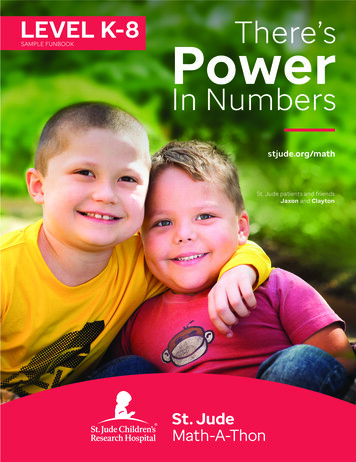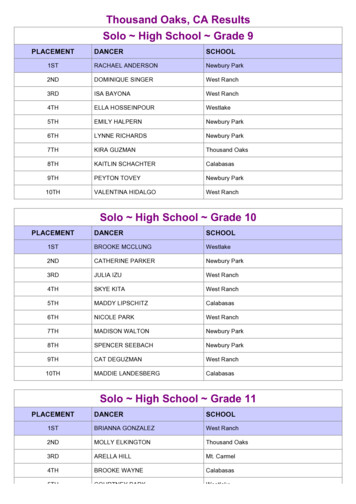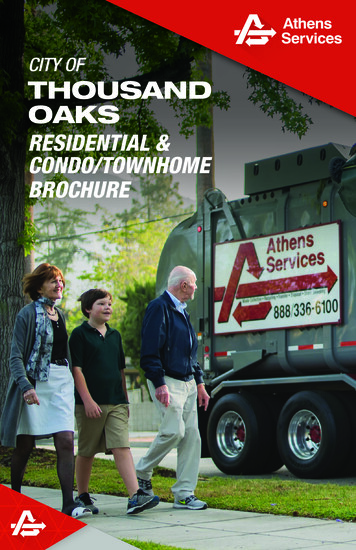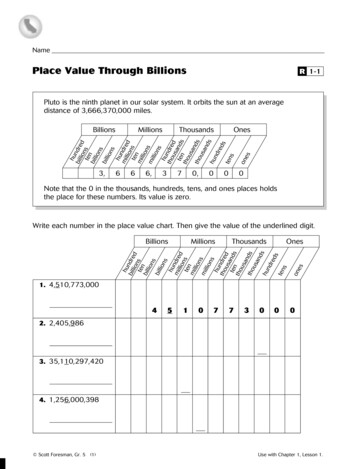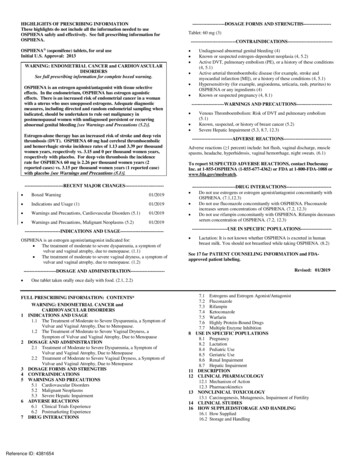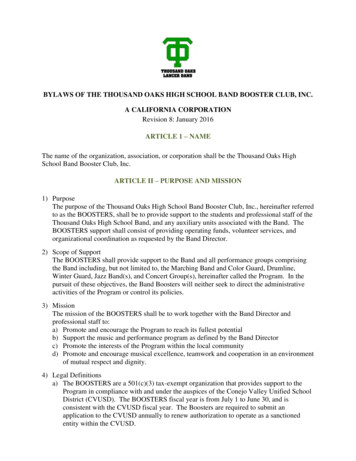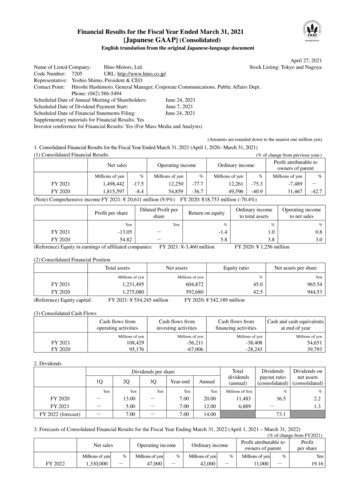
Transcription
Thousand, J., Nevin, A., McNeil, M., & Liston, A. (2006, Nov.) Differentiatinginstruction in inclusive classrooms: Myth or reality? Paper Presented atTED/TAM, San Diego.Jacqueline S. Thousand, ProfessorCalifornia State University San Marcosthousand@csusm.eduAndrea Liston, ProfessorPoint Loma Nazarene Universityehomai@aol.comMary McNeil, Professor and Assistant DeanChapman University&Ann I. Nevin, Professor Emerita ASU, Visiting Professor,Florida International Universitynevina@bellsouth.netPaper presented atAnnual Conference of the Teacher Education Division (TED)of the Council for Exceptional ChildrenSan Diego, CA.November 11, 2006Annual Conference of the Teacher Education Division (TED)of the Council for Exceptional ChildrenSan Diego, CA.AbstractThe authors examine the literature that sets the foundation for a lesson design cycle fordifferentiating instruction in inclusive classrooms. Use the cycle to differentiate at thefour design points of understanding the learners, delineating content and materials,assessing what learners know, and differentially arranging teaching/learning activities.1
Thousand, J., Nevin, A., McNeil, M., & Liston, A. (2006, Nov.) Differentiatinginstruction in inclusive classrooms: Myth or reality? Paper Presented atTED/TAM, San Diego.2Quality of teacher instruction is a key component of both NCLB and IDEIA. Thescientific evidence for strategies that elementary, middle school, and high school teacherscan use to differentiate instruction in inclusive classrooms has been well established(Hall, 2002; Meyer & Rose, 2002; Thousand, Villa, & Nevin, 2006; Udvari-Solnar,1996). In this paper, the authors describe the components for universal design fordifferentiating instruction in inclusive classrooms; describe the components of a lessonplanning cycle to differentiate instruction inclusive classrooms; describe the essentialcomponents of and critique examples of lesson plans to differentiate instruction ininclusive classrooms at 3 levels: elementary, middle, and high school; and discussimplications for general and special education teacher preparation.Given state and district curriculum standards and the demands of an increasinglydiverse learner population, how can meaningful learning activities both address thestandards and the educational needs of all of the students in the class without the need toretrofit lessons and units? An alternative to retrofitting is universal design, “ a conceptthat refers to the creation and design of products and environments in such a way thatthey can be used without the need for modifications or specialized designs for particularcircumstances” (Fortini & Fitzpatrick, 2000, p. 581). Curb cuts, an example of universaldesign, are expensive to add after the fact but cost virtually nothing if designed in fromthe start. Universal Design for Learning is the application of the universal designconcepts to education so that curriculum can be accessed without the need for specializedmodifications and adaptations for particular students. Universal Design for Learningprovides a way for educators to view diversity in children as a strength instead of aproblem. Wiggins and McTighe (2005), the originators of the backward design approachto curriculum and unit development, agree that good curricular and instruction planningbegins with the identification of worthwhile, desired results – things worth knowing anddoing and understandings that are likely to endure and transfer to other tasks and settings.Collectively, we have extensive experience with teachers who use universaldesign for learning requires teachers in inclusive classrooms. They exhibit collaborativeand creative dispositions and actions in order to inventing new ways to facilitatecurriculum access for all students. The Differentiating Instruction through UniversallyDesigned Learning template is an effective tool for facilitating collaborative and creativethinking among co-teachers as they go through the decision-making steps of theDifferentiating Instruction through Universally Designed Learning Lesson PlanningCycle. For more detailed information about implementing this cycle and template, seeThousand, Villa, & Nevin (2007).The authors of the template for the lesson plan provides suggestions for howinclusive classroom teachers might think about essential questions at each of the fourdesign points (i.e., students, content, product, process) as well as to pause and reflectabout individual students who may need unique supports at each design point. Becausethis is a lesson plan template ideally crafted and executed by two or more teachers, one ofthe four “Process of Instruction” columns includes the four types of co-teachingarrangements a teaching team can use (Villa, Thousand, & Nevin, 2004). Additionally,
Thousand, J., Nevin, A., McNeil, M., & Liston, A. (2006, Nov.) Differentiatinginstruction in inclusive classrooms: Myth or reality? Paper Presented atTED/TAM, San Diego.3the lesson plan format leads you to an implementation phase where co-teachers are askedto make decisions about what each co-teacher will do before, during and after the lessonto ensure that the delivery and assessment of content occurs as planned. Collaborativelydeciding how to answer these questions ensures that all partners in the co-teachingventure are clear about their own and each other’s instructional roles and responsibilitiesGatheringFacts AbouttheLearnersPause &ReflectDifferentiateContent &MaterialsPause &ReflectPause &ReflectDifferentiateHow LearnersShow WhatThey KnowDifferentiateInstructionalProcessesPause &ReflectDifferentiated Instruction through Universally Designed Learning Planning CycleThe lesson plan template ends with a reflection phase that includes questions forco-teachers to consider about when they will meet to reflect upon and evaluate theeffectiveness of their efforts to differentiate instruction. They can reflect on to whatextent they each engaged fully and systematically in a recurring planning-analysisreflection cycle that promotes co-teachers’ communication with one another and toevaluate the overall effectiveness of their instruction. Of course, the implementation ofany lesson gives co-teachers new facts about their students as they observe studentperformance during the lesson and examine their products and performances. Thisinformation, then, enables teachers in inclusive classrooms to make even betterdifferentiation decisions as they embark on their next lesson. The informative, recursivenature of the lesson planning cycle emphasizes how the lesson planning steps feed backinto the “Gathering Facts About the Learners” step of the cycle. [See attached lessonplan.)
Thousand, J., Nevin, A., McNeil, M., & Liston, A. (2006, Nov.) Differentiatinginstruction in inclusive classrooms: Myth or reality? Paper Presented atTED/TAM, San Diego.Evaluate the lesson plan developed by Chang’s teachersPLANNING PHASE:Lesson Topic and Name:Content Area(s) Focus:Facts about the Student LearnersContent (What will students learn?)Products (How will students show success?)Process of Instruction (How will students be instructed?)InstructionalFormatsInstructional ArrangementsInstructionalStrategiesSocial and PhysicalEnvironmentIMPLEMENTATION PHASE:Coteaching Approach(es)Date(s) of the lesson?Who are the coteachers?What does each coteacher do before, during, and after implementing the lesson?Coteacher Name:What are the specific tasksthat I do BEFORE thelesson?What are the specific tasksthat I do DURING thelesson?What are the specific tasksthat I do AFTER the lesson?REFLECTION PHASE:The Differentiating Instruction through Universally Designed LearningLesson Plan Template4
Thousand, J., Nevin, A., McNeil, M., & Liston, A. (2006, Nov.) Differentiatinginstruction in inclusive classrooms: Myth or reality? Paper Presented atTED/TAM, San Diego.5ReferencesVilla, R. A., Thousand, J. S., & Nevin, A. I. (2005). A guide to co-teaching: Practicaltips for facilitating student learning. Thousand Oaks, CA: Corwin Press.Fortini, M., & Fitzpatrick, M. (2000). The universal design for promoting selfdetermination. In R. Villa & J. Thousand (Eds.). Restructuring for caring andeffective education: Piecing the puzzle together (2nd ed.), (pp. 575-589).Baltimore: P.H. Brookes Publishing Co.Hall, T. (2002). Differentiated instruction. CAST: National Center on Accessing theGeneral Curriculum: Effective classroom practices report. Retrieved March 16,2006: http://www.cast.org/ncac/index.cfm?i 2876Individuals with Disabilities Education Act (IDEIA) of 1990, 20 United States Congress1412[a] [5]), Reauthorized 1997; 2004.Udvari-Solner, A. (1996). Examining teacher thinking: Constructing a process to designcurricular adaptations. Remedial and Special Education, 17(4), 245- 254.Wiggins, G., & McTighe, J (2005). Understanding by design (2nd ed., expanded)Alexandria, VA: Association for Supervision and Curriculum DevelopmentMeyer, A., & Rose, D. (2002, Dec.). Universal design for individual differences.Educational Leadership, 58(3), 39-43.No Child Left Behind. (NCLB). (2002). HB1. Retrieved March 16, 2006, Tomlinson,C.A., (1999). The differentiated classroom: Responding to the needs of alllearners. Alexandria, VA: Association for Supervision and CurriculumDevelopment.Thousand, J. S., Villa, R. A., & Nevin, A. I. (2007). ). Differentiated instruction:Collaborative planning and teaching for universally designed learning. ThousandOaks, CA: Corwin Press.Villa, R. A., Thousand, J. T., & Nevin, A. I. (2004). A facilitator’s guide todifferentiating instruction.
Thousand, J., Nevin, A., McNeil, M., & Liston, A. (2006, Nov.) Differentiating instruction ininclusive classrooms: Myth or reality? Paper Presented at TED/TAM, San Diego.6AppendixBibliography of 5 Key Research Papers related to Differentiated Instruction using UDL PrinciplesAuthorsCramer, E., Nevin, A.,Salazar, L., &Landa, K. (2006).Co-teaching in anurban, multiculturalsetting: Researchreport. FloridaEducationalLeadership (fall).AbstractThis case study focuses on describing the journey of an urban team of a generaland a special educator who were co-teachers for the same students with whomthey were promoted from 3rd to 4th grade. The teachers wanted to determine theeffects that the continuity of teachers had on student achievement and the coteacher relationship. Reading and social skills showed strong gains for the specialeducation students. Recommendations for successful co-teaching are discussed.These researchers have described the differentiation that can occur within a coteaching environment where students from culturally and linguistically diverseenvironments learn together with their general education teacher and their specialeducator. The looping co-teachers in this diverse, urban setting were found to bea success based upon the professional growth of the teachers and the reading andwriting achievement of the students. While this case study only illustrates oneexample of how to implement such a team, there are lessons to be learned fromthe carefully planned supports and intense training that the co-teachers received.Overall, the social progress and academic achievement of the students withdisabilities coupled with the progress of the general education classmates wholooped encouraged both the co-teachers as well as administrators and the parentsof the children to continue co-teaching arrangements. Another aspect of impactbesides student achievement is the extent to which co-teachers apparently learnedfrom each other. Improvements in differentiating instruction, providingaccommodations, understanding the scope and sequence of the general educationcurriculum, and problem solving were reported by the co-teachers in this studyListon, A. (2006). Coteaching approach todifferentiateinstruction in urbanmulticulturalsecondary educationsettings. Derivedfrom a dissertationaccepted by ArgosyUniversity andincluded in a paperpresented atAmericanAssociation forColleges of TeacherEducation, SanDiego, CA (with E.Cramer, A. Nevin, &J. Thousand) inFebruary 2006.San Diego Unified School District (SDUSD) to adopt a collaborative approachknown as co-teaching at comprehensive school sites where students withdisabilities attend. In co-teaching relationships, a general educator, the master ofcontent, is partnered with a special educator, the master of access. Subsequent toaudiotaped interviews to elicit experiences of co-teachers in four schools whereco-teaching training had been provided, participants completed the Stages ofConcern Questionnaire (SoCQ) developed by Hord, Rutherford, Huling-Austin,and Hall (1987). Based on an analysis of the data collected from these multiplesources, the status of the co-teaching instructional delivery approach wassummarized for the target population (general and special education co-teachersat four selected SDUSD secondary schools that had implemented the co-teachinginstructional delivery approach for a period of not less than one year). This studyverified that the co-teaching approach to differentiate instruction necessitatessecondary schools to re-work the traditional secondary instructional model byrescheduling coursework, supports, and other services. The typical roles ofclassroom educators must be modified. Newly formed co-teaching teams mustexperience ongoing professional development, shared planning time, and acollaborative spirit to resolve the ongoing challenges of teaching in today’sdiverse classroom. When given the appropriate resources and supports, coteachers can differentiate their instruction so as to positively impact the socialand academic achievement of students. Conversely, when co-teaching teamresources and supports are not endorsed, relationships, instruction, andachievement are negatively impacted. The results of this study suggest that tofully put into practice the co-teaching approach to differentiate instruction in highschool classrooms, competent leadership must guide and interconnect thefollowing factors: (a) a systematic implementation framework that includesoperative policies and procedures, (b) a reorganization of resources, training, andcoaching, (c) implementation monitoring, and (d) ongoing revisions forimprovement.
Thousand, J., Nevin, A., McNeil, M., & Liston, A. (2006, Nov.) Differentiating instruction ininclusive classrooms: Myth or reality? Paper Presented at TED/TAM, San Diego.7AuthorsGarrigan, C. M., &Thousand, J. S.(2005, Summer).Enhancing literacythrough co-teaching.New HampshireJournal ofEducation, 8,56 –60.AbstractCo-teachers who differentiated instruction in a California school reportedacademic gains in literacy for students with and without disabilities. Garrigan andThousand (2005) used the STAR Early Literacy system, a computer assistedinstructional program that was developed based on principles of universal designfor learning to meet the needs of advanced learners, challenged learners, andEnglish Language learners. The differentiated instruction arranged by the coteachers made it possible for students with and without disabilities to thrive:“ the literacy performance of the four students with identified disabilitiesincreased dramatically over the five months of the co-teaching intervention. .Pre-post intervention gains exceeded what might be expected, given their lowstarting performances” (p. 59).VanDerhayden, A., &Burns, M. (2005).Using curriculumbased measurementto guide instruction:Effect on individualand groupaccountabilityscores. Assessmentfor EffectiveIntervention, 30(3),15-31.One powerful reason to differentiate assessments is the cumulative benefits thatcome from adding multiple opportunities to demonstrate that learning isoccurring. Students who have had frequent opportunities to speak, act out,demonstrate, and draw their understanding of concepts may be less anxious aboutusing another mode to show what they know (e.g., pencil and paper tests).Differentiated assessment is a way to synthesize one’s knowledge. For example,Vanderhayden and Burns (2005) implemented a curriculum-based measurementsystem to track mathematics progress of k-6 students. The data, collected on abimonthly basis, were used to track mastery at each skill level. Daily data werecollected to track specific instructional interventions when needed. Resultssuggested that children made significant progress within one school year and theschool significantly increased Stanford-9 mathematics scores after implementingthe program.Dolan, R., Hall, T.,Banerjee, M., Chun,E., & Strangman, N.(2005, Feb.).Applying principlesof universal designto test delivery: Theeffect of computerbased read-aloud ontest performance ofhigh school studentswith learningdisabilities. Journalof Technology,Learning, andAssessment, 3(7).The results of this pilot study provide preliminary support for the potentialbenefits and usability of digital technologies in creating universally designedassessments that more fairly and accurately test students with disabilities. Aparticular problem for students with disabilities is the nature of current largescale assessments which are laden with construct-irrelevant factors includingaccess barriers, response barriers, and so on. Testing accommodations such as theread-aloud have led to improvement, but research findings suggest the need for amore flexible, individualized approach to accommodations. In this pilot study,principles of Universal Design for Learning were applied to create a prototypecomputer-based test delivery tool that provides students with a flexible,customizable testing environment with the option for read-aloud of test content.Two contrasting methods were used to deliver two equivalent forms of a NationalAssessment of Educational Progress United States history and civics test to tenhigh school students with learning disabilities. In a counterbalanced design,students were administered one form via traditional paper-and-pencil (PPT) andthe other via a computer-based system with optional text-to-speech (CBT-TTS).Test scores were calculated, and student surveys, structured interviews, fieldobservations, and usage tracking were conducted to derive information aboutstudent preferences and patterns of use. Results indicated a significant increase inscores on the CBT-TTS versus PPT administration for questions with readingpassages greater than 100 words in length. Qualitative findings supported theeffectiveness of CBT-TTS, which students generally preferred over PPT.
Excerpted from Thousand, J., Villa, R., & Nevin, A. (2007, anticipated). Differentiated instruction: Collaborative planningand teaching for universally designed learning (Chapter 11). Thousand Oaks, CA: Corwin Press. ISBN #1-4129-3861-98Co-teaching Universal Design Lesson Plan Template: Middle Level Mathematics for Rosa and ClassmatesPLANNING PHASE:Lesson Topic and Name:Algebra 1Content Area(s) Focus: 20 topicsFacts about the Student LearnersWho are our students and how do they learn?Several students prefer learning in small group and partner activities, only a few prefer to work alone, and about½ the class prefers hands-on concrete learning activities.What are our students’ various strengths, languages, cultural backgrounds, learning styles, and interests?Students include a multicultural mix of Hispanic/Spanish speakers, Anglos, African Americans, Asian Americans.What are our students’ various Multiple Intelligences (i.e., verbal-linguistic, logical-mathematical, visual/-spatial, musical,bodily kinesthetic, interpersonal, intrapersonal, naturalist)?About 1/5 of the learners a verbal-linguistic, 1/10 are logical-mathematical, 1/10 are musical, 1/5 are bodilykinesthetic (football, basketball, and swimming teams), and so on.[ALSO See Table 11.1 “Self-Evaluation Rubric” for Mid-term Evaluation of Algebra I content completed by theclass.]What forms of communication (e.g., assistive technology) do our students use? All students are computer-literate andhave access to email and internet.Pause and Reflect About Specific StudentsAre there any students with characteristics that might require differentiation in the content, product, or process of learning?Rosa is an English language learner (as are at least 4 others); Rosa’s ability to read in English is about 2 years below the level ofdifficulty for the Algebra textbook. In addition, Rosa may need support for impulsivity control (use of inappropriate language whfrustrated).
Excerpted from Thousand, J., Villa, R., & Nevin, A. (2007, anticipated). Differentiated instruction: Collaborative planningand teaching for universally designed learning (Chapter 11). Thousand Oaks, CA: Corwin Press. ISBN #1-4129-3861-9Content9Products Showing Student Success(What will students learn?)What are the academic and/or social goals?(How will students convey their learning?)In what ways will the learning outcomes be demonstrated?Applying algebra 1 concepts (academic) in a way thatcontributes to solving problems (social interaction)A menu of options related to preferences in learning stylesWhat content standards are addressed?California Standards: Mathematics: Algebra 1[Also See Table 11.2.]Differentiation Considerations:In what order will concepts and content be taught?Simultaneous review and expansion of currentskills in 20 different topicsWhat multi-level and/or multi-sensory materials do theco-teachers need to facilitate access to thecontent?Hands-on learning centers (e.g., computermodeling for displaying algebraic functions)What multi-level goals are needed for all students tomeaningfully access the content?Rosa has social goals related to appropriate language inclass, anger management, and/or impulsivity control.[See Tables 11.3 for an example of one of the learningstations.]Differentiation Considerations:What are multiple ways students can demonstrate theirunderstandings (e.g., Multiple Intelligences, multi-leveland/or multi-sensory performances)?What authentic products do students create?Skits of famous mathematicians from around the world & howthey use algebra 1 concepts; visual graphicrepresentations of algebraic functions; responses toconstructivist question-and-answer procedures; etc.What are the criteria teacher(s) use to evaluate the products?Process Evaluation (Exit Slip shown in Table 11.6)Outcome Evaluation (Post tests and authentic project outcomes)Pause and Reflect About Specific StudentsAre there any students who require unique ways of showingwhat they know?Pause and Reflect About Specific StudentsAre there any students who require unique or multi-levelobjectives or materials? No.Yes; it’s apparent that Rosa can express her knowledgeusing drama and artistic expression better thantraditional pencil-paper testing.
Excerpted from Thousand, J., Villa, R., & Nevin, A. (2007, anticipated). Differentiated instruction: Collaborative planningand teaching for universally designed learning (Chapter 11). Thousand Oaks, CA: Corwin Press. ISBN #1-4129-3861-910Process of Instruction(How students engage in g p sCommunity referencedlearning?NoService Cooperative learningstructures?Yes [See Table 11.5 foraccountability system.]Other? (Tutorial,teacher-directed smallgroup) Yes.InstructionalStrategiesConsiderationsChoose researchbased strategies?Yes—constructivistteaching in math[See Table 11.4 forCGI elements.]Apply concepts frommultiple intelligencestheory?Yes.Social and PhysicalEnvironmentConsiderationsRoom arranged?Use of spacesoutside of class?Yes—media(library) andcomputer labCo-teachingApproach(es)OptionsSupportive?Media andComputer labpersonnelParallel?Learning Stationmonitoring sharedco-equallySocial norms?Yes—explicitinstruction in how to be Complementary?a partner learnerNoUse Taxonomies?Team Teaching?Positive behaviorApplication andsynthesis of learning supports?NoYes—especially forresolving disagreements Students as Coagreeablyteachers? (e.g., peertutors and cooperativeSelf-monitoringlearning structuresappropriate remarksunder instructionalarrangements)Yes
Excerpted from Thousand, J., Villa, R., & Nevin, A. (2007, anticipated). Differentiated instruction: Collaborative planningand teaching for universally designed learning (Chapter 11). Thousand Oaks, CA: Corwin Press. ISBN #1-4129-3861-911Pause and Reflect About Specific StudentsWhat student-specific teaching strategies do select students need? What specific systems of supports (e.g., assistive technology), aids (e.personal assistance, cues, contracts), or services (e.g., counseling) do select students need?Rosa was scheduled to see the school counselor once every other week to learn appropriate language to express frustration (andrequest help and assistance) as well as to express her feelings and sadness about leaving family members behind in Nicaragua whher family fled to USA (survivor guilt).Who are the Co-teachers:JuppDonderoIMPLEMENTATION PHASE:MediaComputer LabWhat is/are the date(s) of the lesson? January 20–February 20What does each co-teacher do before, during, and after implementing the lesson?Co-teacherNameÆWhat are the specifictasks that I doBEFORE the lesson?JuppDonderoMedia/LibraryComputer LabCheckavailability ofmaterials.Checkavailability ofmaterials.Check with Juppre suitability ofmaterials for theMathematiciansProject.What are thespecific tasks that Ido DURINGUse CGI andinformationfrom Exit Slipsto tutorUse CGI andinformation fromExit Slips totutor specificMonitor andassist studentsto accessappropriateCheck withDondero rematchingtextbook andstate standard tosoftware.Monitor andassist students’use of thesoftware to model
Excerpted from Thousand, J., Villa, R., & Nevin, A. (2007, anticipated). Differentiated instruction: Collaborative planningand teaching for universally designed learning (Chapter 11). Thousand Oaks, CA: Corwin Press. ISBN #1-4129-3861-9the lesson?specific topics.topics.information.algebra functions.What are thespecific tasks that Ido AFTER thelesson?Collect &Review ExitSkips.Collect &Review ExitSlips.Collect ExitSlips and sendto Jupp orDondero.Collect Exit Slipsand send to Juppor Dondero.12REFLECTION PHASE:Where, when, and how do co-teachers debrief and evaluate the outcomes of the lesson?Daily de-briefingsHow did students do?End of month re-evaluation of student mastery of topics.Were needs of the learners met?Increased participation at every learning station; increased competence; increased positive mental attitudesabout algebraWhat are recommendations for the design of the next lesson(s)?Students want to meet people in the ‘real world’ who use Algebra 1 concepts. Teachers are in the process ofidentifying various professionals and blue collar workers who might be willing to participate with student studygroups.
Excerpted from Thousand, J., Villa, R., & Nevin, A. (2007, anticipated). Differentiated instruction: Collaborative planningand teaching for universally designed learning (Chapter 11). Thousand Oaks, CA: Corwin Press. ISBN #1-4129-3861-913SUPPLEMENTARY MATERIALS used in this lesson attachedTable 11.1 Teacher-Developed Mid-Year Academic Self-Assessment for Algebra 1*Directions: You have studied these topics so far this year in Algebra 1.Please evaluate your performance in each topic.TOPIC1. Operations with integers2. Area, perimeter of rectangles, triangles, circles3. Setting up Guess and Check (Estimate) Tables4. Solving probability problems5. Using a table to graph an equation6. Graphing linear equations7. Finding the slope of a line8. Finding the slope between 2 points9. Using slope and y-intercept to graph a line10. Distributive property11. Multiplying using generic rectangles12. Solving equations in 2 variable13. Simplifying expressions by combining terms14. Solving systems of equations by substitution15. Solving proportions by cross-multiplying12345I have noclue whatthis is.I recognizethe termbut couldnot do thison my own.With a toolkitand someguidance, Ican do this.With atoolkit, Ican do thison my own.I know thisand canexplain toothers.
Excerpted from Thousand, J., Villa, R., & Nevin, A. (2007, anticipated). Differentiated instruction: Collaborative planningand teaching for universally designed learning (Chapter 11). Thousand Oaks, CA: Corwin Press. ISBN #1-4129-3861-91416. Solving equations using “fraction busters”17. Graphing quadratic equations (parabolas)18. Applying the Pythagorean Theorem19. Simplifying radicals (square roots)20. Factoring polynomials w/ diamonds/generic rectanglesSOURCE: The rubric was adapted from one created by Carrie Kizuk, math co-teacher at Twin Valley High School, Morgantown,PA; used with permission.
Excerpted from Thousand, J., Villa, R., & Nevin, A. (2007, anticipated). Differentiated instruction: Collaborative planningand teaching for universally designed learning (Chapter 11). Thousand Oaks, CA: Corwin Press. ISBN #1-4129-3861-9Table 11.2 Key Mathematics Standards Guiding the UDL LessonsTopic1. Operations with integers2. Area, perimeter of rectangles, triangles, circles3. Setting up Guess and Check (Estimate) Tables4. Solving probability problems5. Using a table to graph an equation6. Graphing linear equations7. Finding the slope of a line8. Finding the slope between 2 points9. Using slope and y-intercept to graph a line10. Distributive property11. Multiplying using generic rectangles12. Solving equations in 2 variables13. Simplifying expressions by combining terms14. Solving systems of equations by substitution15. Solving proportions by cross-multiplying16. Solving equations using “fraction busters”17. Graphing quadratic equations (parabolas)18. Applying the Pythagorean theorem19. Simplifying radicals (square roots)20. Factoring polynomials w/ diamonds/generic rectangles*Indicates differentiation of instructional goalsStandardStandard 13Standard 1Standard 24 (reasoning)Standards not available for this grad
California State University San Marcos thousand@csusm.edu Andrea Liston, Professor Point Loma Nazarene University ehomai@aol.com Mary McNeil, Professor and Assistant Dean Chapman University & Ann I. Nevin, Professor Emerita ASU, Visiting Professor, Florida International University nevina@bellsouth.net Paper presented at
